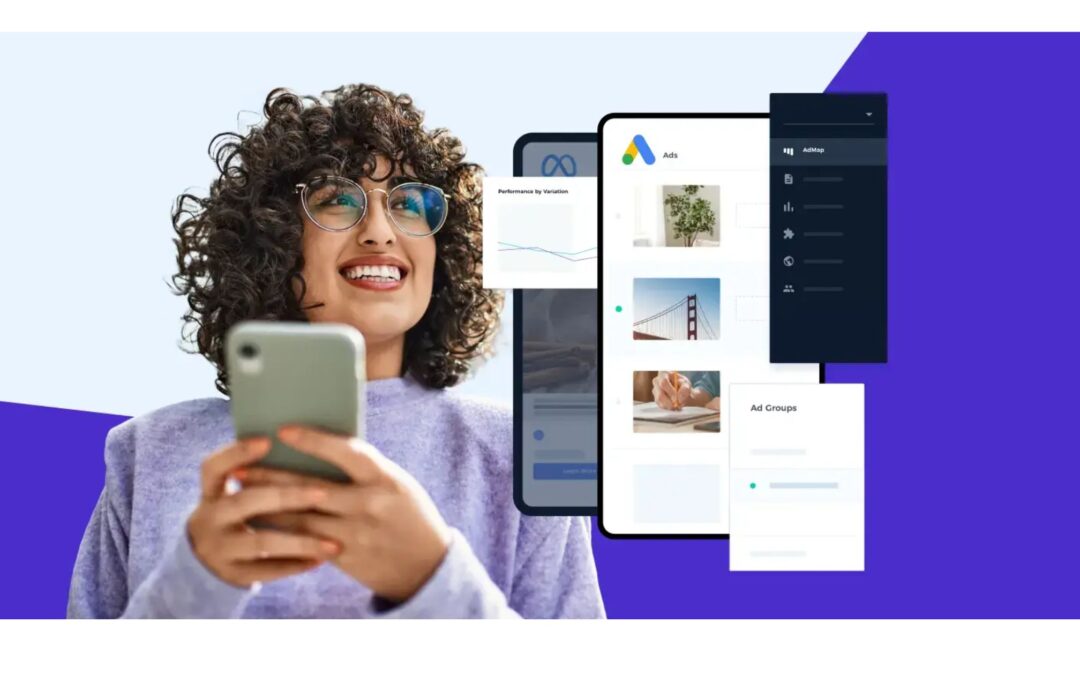Navigating the different Google Ads campaign types can be daunting, especially when trying to determine the best fit for your business. With a variety of options available, it’s easy to feel overwhelmed by the choices. Google Ads is a powerful tool that allows businesses to reach their target audience and effectively promote their products or services. However, not all types of Google Ads are suitable for every situation. Understanding the distinct features and benefits of each campaign type is crucial to selecting the one that aligns best with your business goals. By gaining a deeper insight into the various Google Ads campaigns, you can make informed decisions that enhance your advertising strategy and maximize your reach and ROI. Find out which Google Ads campaign type is right for your business to ensure you are leveraging this powerful platform to its full potential.
CONTENT
- Search
- Display
- Video
- Shopping
- Smart
- Performance Max
- App
- Discovery
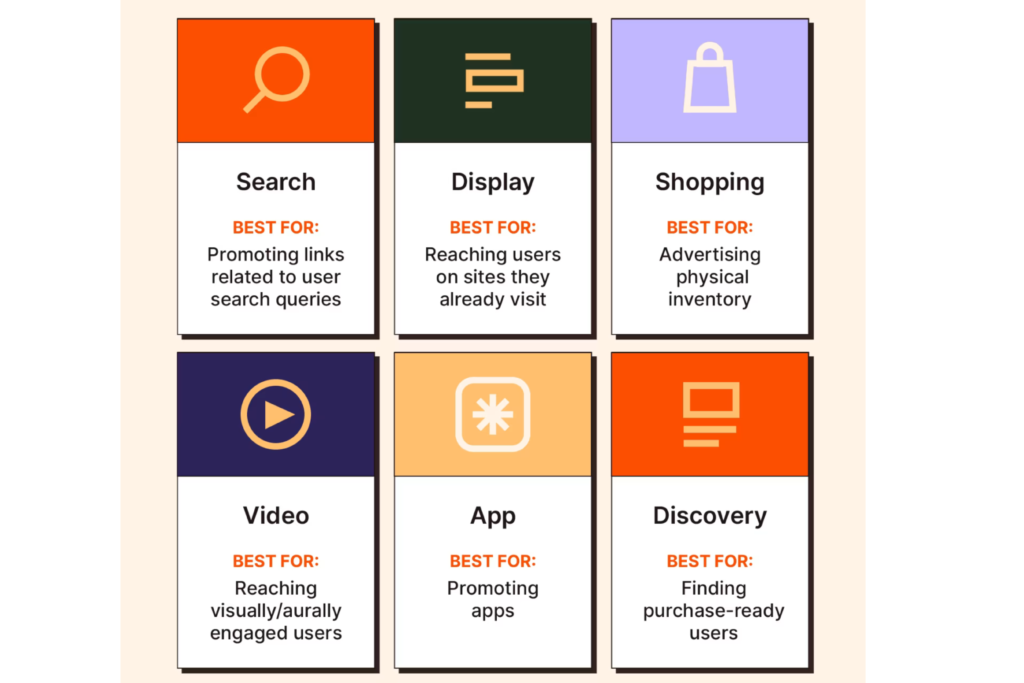
Let us understand the Objectives of Google ads which can help us choose which type of Google ad to choose our Google Ads campaign
1. Sales
Objective: The primary goal is to drive sales directly through your ads, whether those sales happen online, via phone, or in your physical store.
- Online Sales: This objective focuses on increasing transactions on your website. Google Ads can target users with a high intent to purchase, using strategies such as Shopping campaigns and Dynamic Search Ads.
- Phone Sales: By including call extensions and call-only ads, businesses can encourage users to call directly from the ad, converting leads into sales over the phone.
- In-store Sales: For physical store locations, local inventory ads and location extensions help drive foot traffic by showing nearby customers the products available in your store.
2. Leads
Objective: The goal is to capture potential customer information, such as emails, phone numbers, or inquiries, to convert into sales at a later time.
- Lead Forms: Using lead form extensions or dedicated landing pages, businesses can collect information from users interested in their services or products.
- Contact Information: Ads can be optimized to encourage users to sign up for newsletters, request quotes, or schedule appointments, thereby generating valuable leads.
- Remarketing: Targeting users who have previously visited your site but didn’t convert can help in nurturing and converting these leads over time.
3. Website Traffic
Objective: The aim is to increase the number of visitors to your website, which can lead to higher brand awareness and potential conversions.
- Search Ads: By targeting relevant keywords, Search campaigns drive traffic from users actively looking for information related to your business.
- Display Ads: These visually appealing ads can attract users across various websites and apps, driving them to visit your site.
- Video Ads: YouTube ads can generate interest and drive traffic by engaging users with compelling video content.
- Smart Campaigns: These use automated systems to optimize ad placements and bidding strategies to drive more website visits.
4. App Promotion
Objective: The goal is to increase the number of downloads and installations of your mobile app.
- Universal App Campaigns: These campaigns automatically optimize ads across Google’s networks, including Search, Play, YouTube, and the Display Network, to promote app installs.
- App Engagement: In addition to driving installs, ads can also encourage users to take specific actions within the app, such as making a purchase or signing up for a service.
- Targeted Ads: Ads can be tailored to reach users who are more likely to be interested in your app based on their past behaviors and interests.
5. Awareness and Consideration
Objective: The primary aim is to increase brand awareness and make potential customers consider your products or services.
- Display Network: Display ads reach a wide audience across millions of websites, helping to build brand recognition.
- Video Ads: YouTube ads can introduce your brand to new audiences and provide engaging content that makes users consider your offerings.
- Discovery Campaigns: These ads appear in feeds across Google’s platforms, such as YouTube, Discover, and Gmail, reaching users when they are most likely to discover new interests.
- Outreach: Campaigns focusing on impressions (CPM) rather than clicks can maximize visibility and engagement with potential customers.
6. Local Shop Visits and Promotions
Objective: The goal is to drive foot traffic to physical store locations and promote local events or offers.
- Local Campaigns: These are designed to bring more customers to your brick-and-mortar locations by showing ads across Search, Maps, YouTube, and the Display Network.
- Location Extensions: Adding your business address and phone number to your ads makes it easier for customers to find and contact you.
- Promotions: Highlighting special offers, events, or sales through localized ad campaigns can attract nearby customers.
- Google My Business: Integrating your Google My Business account with your Google Ads campaigns ensures that local searchers get accurate and enticing information about your store.
Let us Understand Each type of Google Ads Campaign now
1. Google Search Ads
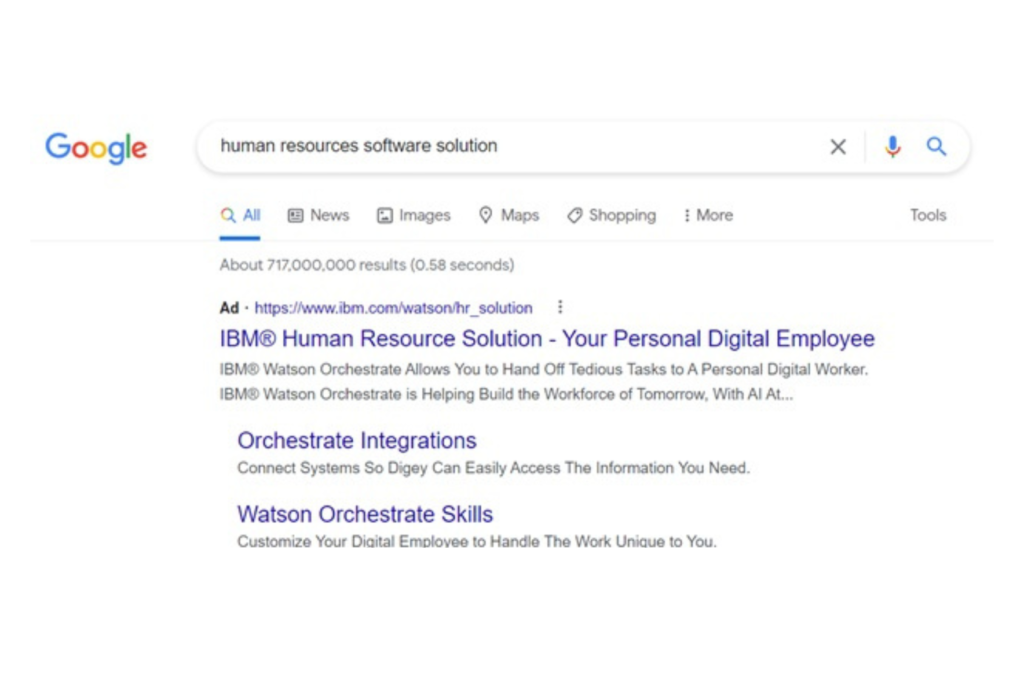
Google Search Ads are a foundational component of Google Ads, designed to display text ads to users when they search for specific keywords on Google’s Search Engine Results Page (SERP). These ads can appear at the top or bottom of the search results and operate on a pay-per-click (PPC) model, meaning businesses only pay when a user clicks on their ad.
How Google Search Ads Work
- Ad Creation: You create an ad targeting specific keywords relevant to your business.
- Bidding: You place a bid, indicating the maximum amount you’re willing to pay for each click on your ad.
- Ad Auction: When a user searches for one of your targeted keywords, your ad competes in an auction against other advertisers bidding on the same keyword.
- Ad Placement: Google evaluates your bid and quality score (a measure of the ad’s relevance and quality) to determine if and where your ad will appear on the SERP.
- Cost Per Click (CPC): If your ad is clicked, you pay a cost that is influenced by the competitiveness of the keyword and your ad’s quality score.
Types of Google Search Ads
- Responsive Search Ads:
- These ads allow you to provide up to 15 headlines and 4 descriptions.
- Google automatically tests different combinations to determine which perform best for different search queries.
- Benefits include increased ad relevance and potentially higher performance due to dynamic optimization.
- Call Ads:
- Designed to drive phone calls to your business.
- The headline is a clickable phone number, encouraging users to call directly from the ad.
- Important to use call tracking to measure the effectiveness of these ads.
- Dynamic Search Ads:
- Automatically generate ad headlines and landing pages using content from your website.
- Ideal for businesses with well-developed websites.
- Simplifies ad creation and keeps ad content fresh by leveraging existing website information.
Placement and Reach
Google Search Ads can appear across Google’s Search Network, including:
- Google Search: Primary search engine results page.
- Google Play: For searches related to apps and content.
- Google Maps: For location-based searches.
- Shopping Tab: For product-related searches.
- Search Partners: On various partner websites that display Google Ads.
05 Tips to Optimize Search Ads
1. Optimise your Quality Score
To get the best results from your Google Search Ads, focus on improving your Quality Score. This score is determined by how relevant your ads are to the keywords you are targeting. Make sure your ad copy is compelling and matches what users are searching for. Additionally, your landing pages should provide a good user experience and be directly related to the content of your ads. When your ads are more relevant and your landing pages are well-optimized, you get better placement and lower costs per click.
2. Use Negative Keywords
To ensure you’re not wasting money on irrelevant clicks, use negative keywords. These are terms that you exclude from your campaigns because they don’t relate to your business. Regularly check your search term reports to find keywords that aren’t bringing in the right traffic and add them to your negative keyword list. This helps you focus your budget on the keywords that matter most to your business and increases your ad efficiency.
3. Leverage Ad Extensions
Ad extensions are additional pieces of information you can add to your ads, such as extra links to your website, phone numbers, or locations. Using ad extensions makes your ads more informative and can significantly increase your click-through rates. They give users more reasons to click on your ads by providing valuable information right in the search results, making your ads stand out and offering more ways for potential customers to interact with your business.
4. Implement A/B Testing
To find the best-performing ads, continually test different versions of your ad copy and landing pages. A/B testing involves creating multiple versions of an ad with different headlines, descriptions, or calls to action to see which one performs best. Google’s responsive search ads can help automate some of this testing by mixing and matching your headlines and descriptions to find the most effective combinations. Regular testing and optimization ensure that your ads stay effective and relevant.
5. Monitor and Adjust Bids
Keep a close eye on how your campaigns are performing and adjust your bids based on that performance. Review which keywords are driving the most conversions and consider increasing bids on those, while lowering bids on less effective keywords. Use bid adjustments to optimize for specific times of day, locations, and devices that perform best. Regularly refining your bid strategy helps you maximize your return on investment by focusing your budget on the highest-performing areas.
2. Google Display Ads
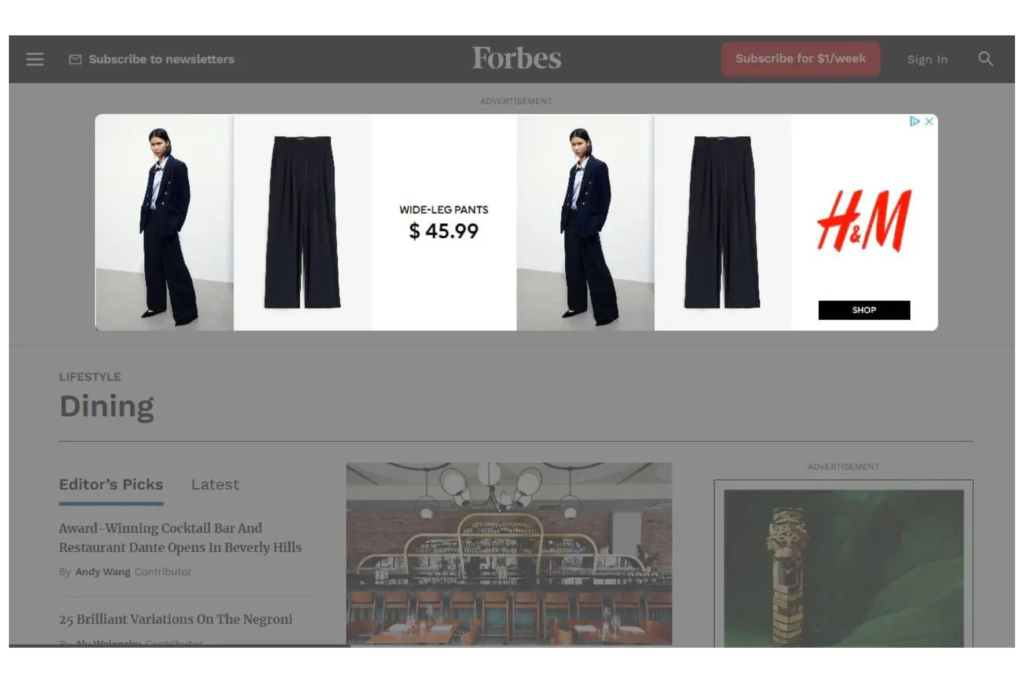
Google Display Ads differ significantly from Search Ads as they focus on displaying visual ads (images, videos, and text) across websites, apps, and other online platforms within the Google Display Network (GDN). This network comprises about 35 million websites, blogs, and apps that have partnered with Google to show ads to their audience. Unlike Search Ads, which target users based on their search queries, Display Ads target users based on their online behaviors, interests, and other targeting parameters.
How Google Display Ads Work
- Ad Creation: You create visually engaging ads using images, videos, or text. These ads can be customized to match the look and feel of the websites or apps where they will appear.
- Targeting: Instead of targeting keywords, Display Ads target placements (specific websites or apps), audiences (user demographics, interests, or behaviors), and topics (relevant content categories).
- Ad Placement: Ads are shown on sites and mobile apps across the Google Display Network, reaching users as they browse various websites or use apps.
- Push Marketing: Display Ads use a push marketing strategy, showing ads to users based on targeting parameters, even when they are not actively searching for related content.
Types of Google Display Ads
- Single Image Display Ads:
These are static ads created from pre-designed images. They are straightforward and can be very effective for brand awareness. Ideal for conveying a clear, single message or call-to-action (CTA).
- Responsive Display Ads (RDA):
RDAs dynamically cycle through combinations of images and text to find the best-performing ad for various placements. They adapt to different ad spaces and formats, optimizing performance automatically. Simplify the ad creation process by allowing multiple assets (images, headlines, logos) to be uploaded, which Google then tests in various combinations.
Benefits of Google Display Ads
- Brand Awareness: Display Ads are excellent for driving brand awareness due to their ability to achieve high volumes of relevant impressions.
- Broad Reach: They reach a wide audience across millions of websites and apps.
- Visual Appeal: The use of images and videos makes these ads visually engaging and more likely to capture user attention.
- Indirect Conversions: Display Ads can trigger branded searches and contribute to indirect conversions through view-through conversions (when a user sees an ad but converts later without directly interacting with the ad)
05 Tips to Optimize Display Ads
- Utilize Audience Targeting
To make your Google Display Ads more effective, focus on targeting the right audience. You can create custom audiences based on what people are interested in, their habits, or what they are currently researching online. Another powerful method is remarketing, which targets users who have previously visited your website or app. This helps re-engage potential customers who are already familiar with your brand and encourages them to take action, such as making a purchase or signing up for a service.
- Leverage Responsive Display Ads (RDA)
Responsive Display Ads (RDAs) are highly effective because they automatically adjust their size, appearance, and format to fit available ad spaces. You can upload various images, headlines, logos, and descriptions, and Google will test different combinations to find out which ones perform the best. This automatic optimization ensures that your ads are always shown in the most effective format, maximizing your reach and engagement without requiring constant manual adjustments.
- Use High-Quality Visuals
The quality of your visuals is crucial in attracting and retaining the attention of your audience. Use high-resolution images and engaging videos that are visually appealing. Make sure your ads are consistent with your brand’s visual identity, including colors, fonts, and logos, to reinforce brand recognition. High-quality visuals not only capture attention but also help build trust and credibility with your audience.
- Monitor and Adjust Placements
Regularly reviewing where your ads are displayed is essential for maintaining their effectiveness. Use placement reports to see which websites or apps are showing your ads and exclude those that are not performing well or are not relevant to your target audience. Additionally, you can manually choose specific websites or apps that are highly relevant to your audience to ensure better performance. This careful monitoring and adjustment help you avoid wasting ad spend on low-performing placements and improve your overall campaign effectiveness.
- Test Different Ad Formats
Continuously testing different ad formats is key to understanding what works best for your audience. Conduct A/B testing by running different versions of your ads, such as comparing single image ads with responsive ads, to see which performs better. Experiment with various designs and messaging to find out what resonates most with your audience. This ongoing testing and optimization process helps you refine your ads for maximum impact and return on investment.
3. Video Ad Campaign
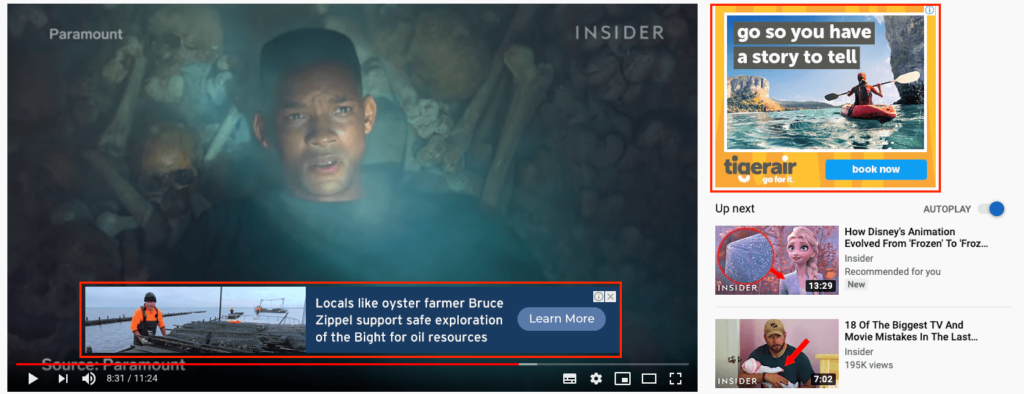
Google Video Ads, primarily served through YouTube and other video-sharing platforms, are a highly engaging format of Google Ads that allow businesses to deliver dynamic and immersive messages to their audience. Unlike text or image-based ads, video ads use audio-visual content to attract and engage viewers, making them particularly effective for storytelling and demonstrating products or services.
How Google Video Ads Work
- Ad Creation: Businesses create video ads that are typically 6 to 15 seconds long, though longer formats are also available.
- Bidding and Targeting: Similar to Display campaigns, you bid to have your video ads shown on specific placements. Targeting is based on audience demographics, interests, behaviors, and specific placements on YouTube and other sites.
- Ad Formats: Video campaigns offer several types of ad formats, each serving different purposes and appearing in various locations within the Google ecosystem.
Who They’re Best For
- Complex Products or Services: Businesses with products or services that are hard to describe in text can benefit from showing how they work through video.
- Brand Awareness: Ideal for businesses looking to drive brand awareness and engagement in specific target markets.
- Engagement and Conversions: Effective for generating leads, driving traffic, and increasing conversions through compelling video content.
Types of Google Video Ads
- Skippable In-Stream Ads:
- Description: These ads play before, during, or after other videos and can be skipped by viewers after 5 seconds.
- Use Case: Great for driving engagement with longer messages since viewers can skip if they aren’t interested.
- Non-Skippable In-Stream Ads:
- Description: These ads also play before, during, or after videos but must be watched in full (up to 15 seconds).
- Use Case: Useful for delivering short, impactful messages that need to be seen by viewers.
- In-Feed Video Ads:
- Description: These ads appear as a thumbnail image and text on YouTube search results, next to related videos, or on the YouTube homepage.
- Use Case: Effective for enticing users to click and watch longer content, similar to how organic YouTube video suggestions work.
- Bumper Ads:
- Description: Non-skippable ads up to 6 seconds long that play before, during, or after a video.
- Use Case: Ideal for brief, memorable messages and brand reinforcement.
- Outstream Ads:
- Description: Mobile-only ads that appear on Google video partner sites, starting with the sound off.
- Use Case: Useful for broadening reach to mobile users and encouraging them to engage with the sound on.
- Masthead Ads:
- Description: These ads autoplay without sound for up to 30 seconds at the top of the YouTube homepage feed. Available on a reservation basis.
- Use Case: Best for major campaigns aiming for maximum visibility and reach on YouTube.
5 Tips to Optimize Video Ads
1. Target the Right Audience
To make sure your video ads reach the people most likely to be interested, focus on targeting the right audience. Use Google’s tools to choose specific demographics like age, gender, and income level. You can also create custom audiences based on what people are interested in or their past interactions with your brand. By being precise with your targeting, you ensure your ads are seen by those who are most likely to engage with them.
2. Create Engaging Content
The content of your video ad is crucial. Start with a strong, attention-grabbing hook within the first few seconds to capture viewers’ interest. Your message should be clear and concise, especially if viewers can skip the ad after 5 seconds. Make sure your key points and brand message are conveyed quickly so even those who don’t watch the whole ad get the main idea. Engaging content keeps viewers interested and encourages them to take action.
3. Use YouTube Analytics
Regularly check how your ads are performing using YouTube Analytics. Look at metrics like how many people are watching your ad, how long they stay engaged, and whether they take the actions you want them to. These insights help you understand what’s working and what isn’t. By analyzing this data, you can make informed decisions about how to tweak your ads, such as adjusting your targeting or changing elements of your video to improve performance.
4. Leverage A/B Testing
A/B testing is a powerful way to see what works best in your video ads. Create different versions of your ads with variations in length, calls to action (CTAs), and visuals. Run these versions simultaneously to see which one performs better. This method allows you to understand which elements of your ad are most effective and refine your approach accordingly. Continuous testing and optimization can significantly enhance the success of your video campaigns.
5. Incorporate Clear CTAs
Every video ad should have a clear and compelling call to action. Whether you want viewers to visit your website, subscribe to your channel, or make a purchase, tell them exactly what to do. Using interactive elements like end screens and cards on YouTube can further guide viewers to take the next step. A strong CTA makes it easy for viewers to understand what action to take, increasing the likelihood of them following through.
4. Shopping Ads Campaign
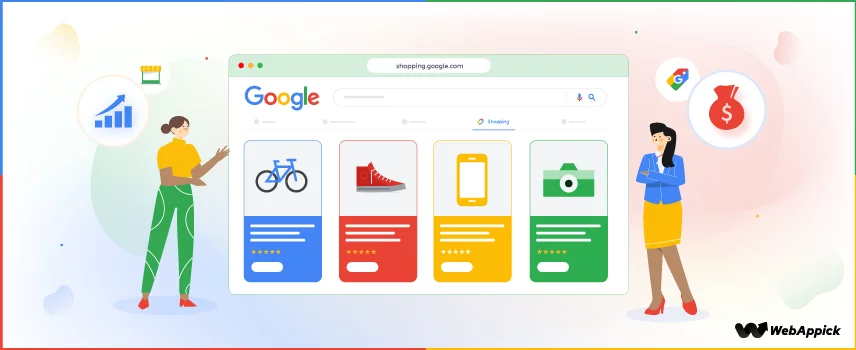
Shopping ads are visual advertisements displayed on Google’s Search and Shopping tabs, showcasing product information to users. Unlike text-based ads, these ads present products with images and details like price, enabling users to easily compare offerings.
How Shopping Ads Work
Shopping ads operate through a product feed stored in Google Merchant Center, containing essential product information like price and availability. Google then uses this feed to generate ads displayed on the SERP. Targeting relies on negative keywords and other parameters instead of traditional keywords.
Who They’re Best For
Shopping ads are ideal for eCommerce businesses aiming to boost online sales and local retailers seeking to drive in-store traffic. They are particularly beneficial for showcasing visually appealing products and facilitating comparison shopping.
Types of Shopping Ads
- Product Shopping Ads: Standard ads visible on the SERP, featuring product images and relevant details.
- Local Inventory Ads: Display store inventory to nearby users, indicating product availability for in-store pickup.
05 Tips to Optimize Shopping Ads
- Optimize Product Titles and Descriptions:
Your product titles and descriptions play a crucial role in attracting users and convincing them to click on your ads. Craft clear, descriptive titles that accurately represent your products and include relevant keywords that users are likely to search for. Ensure that your descriptions provide detailed information about the features, benefits, and unique selling points of your products. By optimizing your titles and descriptions, you can improve the visibility and relevance of your ads, leading to higher click-through rates and increased conversions.
- Use High-Quality Images:
High-quality images are essential for showcasing your products in the best possible light and capturing the attention of potential customers. Utilize visually appealing, high-resolution images that accurately represent your products and highlight their key features. Make sure that your images are clear, well-lit, and properly cropped to focus on the product. High-quality images not only enhance the overall appearance of your ads but also help build trust and credibility with users, leading to higher click-through rates and improved user engagement.
- Monitor and Adjust Bids:
Bidding strategies can have a significant impact on the performance of your Shopping ads. Regularly monitor the performance of your ads and adjust your bids based on performance data to ensure optimal ad placement and maximize return on investment (ROI). Increase bids for top-performing products or categories to maintain visibility and drive more traffic, while decreasing bids for underperforming products to minimize wasted ad spend. By continuously optimizing your bids, you can improve the overall effectiveness of your Shopping campaigns and achieve better results.
- Utilize Negative Keywords:
Negative keywords are terms that you don’t want your ads to appear for. By using negative keywords, you can exclude irrelevant search queries and improve the targeting accuracy of your ads, ensuring that they are shown to users who are most likely to convert. Regularly review search query reports to identify irrelevant keywords that trigger your ads and add them as negative keywords to prevent your ads from showing for those queries. By refining your targeting with negative keywords, you can increase the relevance of your ads and improve their overall performance.
- Optimize Product Feed
Your product feed is the foundation of your Shopping campaigns and plays a crucial role in determining the relevance and effectiveness of your ads. Continuously update and optimize your product feed with accurate and up-to-date information, including prices, availability, and product attributes. Ensure that your product feed is properly structured and organized, with clear and consistent product titles, descriptions, and images. Regularly review performance metrics and make adjustments to your product feed as needed to improve campaign performance and achieve your advertising goals. By optimizing your product feed, you can enhance the relevance and effectiveness of your Shopping ads, leading to better results and higher ROI.
5. Performance Max Ad Campaign

Performance Max Ads are a versatile and automated type of Google Ads campaign designed to optimize for specific advertising goals across all of Google’s networks. These ads consolidate all your advertising assets and distribute them across multiple platforms, including the Search Engine Results Page (SERP), Google Maps, the Google Display Network, YouTube, Gmail, and the Discovery networks. This holistic approach enables advertisers to maximize their reach and efficiency by managing a single campaign that targets multiple channels simultaneously.
How Performance Max Ads Work
Performance Max Ads utilize Google’s advanced machine learning algorithms to optimize ad delivery based on the goals, assets, and information you provide. Here’s a detailed breakdown of how they operate:
- Goal Setting: You start by setting a primary campaign goal, such as increasing conversions, achieving a target return on ad spend (ROAS), or boosting sales. This goal guides the AI in its optimization efforts.
- Asset Provision: You supply a variety of creative assets, including text, images, videos, logos, audience signals, and product feeds. These assets are used to generate different ad formats.
- Automated Ad Creation: Google’s AI dynamically combines these assets to create ads tailored to various placements. For instance, it might create a video ad for YouTube, a text ad for search, and an image ad for the Display Network.
- Real-Time Optimization: The AI continuously learns from user interactions and performance data, adjusting bids, budgets, and asset combinations in real-time to optimize for the best results.
- Cross-Channel Delivery: The ads are distributed across all of Google’s properties, ensuring broad reach and exposure. This includes search results, display ads on partner websites, video ads on YouTube, interactive ads in Gmail, and more.
Who They’re Best For
Performance Max Ads are particularly beneficial for:
- Ecommerce Businesses: These ads are highly effective for online retailers looking to drive sales and revenue. They can automatically showcase products and optimize for conversions based on user behavior and purchase intent.
- Advertisers with Established Goals: Ideal for businesses that have specific conversion goals set up, such as a target CPA (Cost Per Acquisition) or ROAS. Clear goals enable the AI to optimize more effectively.
- Businesses with a Robust Marketing Budget: Performance Max campaigns require a substantial budget (at least $50-100 per day) to gather sufficient data for effective optimization. This makes them better suited for businesses with a healthy advertising budget.
- Experienced Advertisers: Given the complexity of setting up Performance Max campaigns, including the need to provide a wide range of assets and understand the impact on other campaigns, they are best managed by advertisers with experience in PPC (Pay-Per-Click) advertising.
Types of Performance Max Ads
Performance Max campaigns are capable of generating nearly every type of ad across all Google properties. This includes:
- Search Ads: These are text-based ads that appear on the search results page when users enter relevant queries. additionally, They are designed to capture the intent of users actively looking for specific information, products, or services, making them highly effective for driving direct conversions.
- Display Ads: These are banner and image ads shown on websites within the Google Display Network. In addition, Display ads are ideal for reaching a broader audience and can be used to build brand awareness or retarget users who have previously visited your site.
- Video Ads: These ads are displayed on YouTube and other video-sharing platforms. Moreover, Video ads can be particularly engaging and are useful for storytelling, product demonstrations, and conveying complex messages in a visually appealing format.
- Gmail Ads: Interactive ads that appear within Gmail and expand to show detailed information. Gmail ads can mimic the look of regular emails, making them less intrusive and more engaging for users. They are effective for reaching users directly in their inbox.
- Discovery Ads: These ads appear on Google’s Discovery feed, which reaches users across the Discover feed, YouTube home feed, and Gmail Promotions tab. Discovery ads are designed to be visually rich and engaging, helping to capture the attention of users as they browse through personalized content.
05 Tips to Optimize Video Ads
1. Set Clear Goals
To maximize the effectiveness of your Performance Max campaigns, it’s crucial to start by setting clear and well-defined objectives. Therefore, Whether your primary goal is to increase sales, generate leads, boost website traffic, or achieve a specific ROAS (Return on Ad Spend), having clear objectives helps Google’s AI understand what you’re aiming to achieve and optimizes accordingly. In fact, Proper conversion tracking should be set up to measure the success of these goals, which could include tracking purchases, form submissions, or other desired actions on your website. In addition, Regularly reviewing and adjusting your goals based on performance data ensures they remain relevant and achievable as your campaign progresses, allowing you to stay aligned with your overall business objectives.
2. Provide High-Quality Assets
The quality of your creative assets plays a significant role in the success of your Performance Max campaigns. Provide a diverse range of high-resolution images, compelling videos, engaging texts, and professional logos to ensure your ads are adaptable across various placements. It’s essential to optimize these assets for both desktop and mobile viewing, as mobile-friendly assets can significantly enhance user engagement and click-through rates. To keep your audience engaged and prevent ad fatigue, periodically refresh your creative assets with new and relevant content. Finally, Fresh and appealing assets not only maintain user interest but also contribute to better overall campaign performance.
3. Leverage Audience Signals
Effectively leveraging audience signals is key to enhancing the relevancy and engagement of your ads. In short, Start by providing detailed demographic information such as age, gender, and location to help Google’s AI target the right audience. Additionally, use Google’s targeting options to reach users based on their interests and behaviors, enabling you to connect with those who have shown interest in similar products or services. Implementing retargeting strategies can also be highly effective, as it allows you to re-engage users who have previously interacted with your brand, increasing the likelihood of conversions from those already familiar with your offerings.
4. Monitor and Adjust Budgets
Regular monitoring and adjustment of your campaign budgets are essential to optimize performance. Therefore, Consistently review performance metrics such as click-through rates (CTR), conversion rates, and cost per conversion to understand how your campaign is performing. Therefore, Based on these insights, adjust your daily and overall campaign budgets, allocating more resources to high-performing ads while reducing spend on underperforming ones. Correspondingly, Utilizing flexible bidding strategies, such as Target CPA or Target ROAS, allows for real-time adjustments based on auction outcomes, maximizing your ad spend efficiency and ensuring you get the best possible return on investment.
5. Utilize Reporting and Insights
Taking full advantage of Google Ads performance reports and insights can significantly enhance your campaign effectiveness. Use these reports to get detailed insights into how your ads are performing across different channels, looking at key metrics such as impressions, clicks, conversions, and cost per conversion. Particularly, Analyze this data to identify which assets and placements are driving the best results, and use these insights to make informed decisions about future optimizations. Continuously test different variations of your ads through A/B testing to see what works best, experimenting with different headlines, images, videos, and calls to action (CTAs) to optimize for better performance. Therefore, By refining your targeting, assets, and bidding strategies based on data-driven insights, Finally, you can significantly improve the overall effectiveness of your Performance Max campaigns.
6. Smart ad Campaign
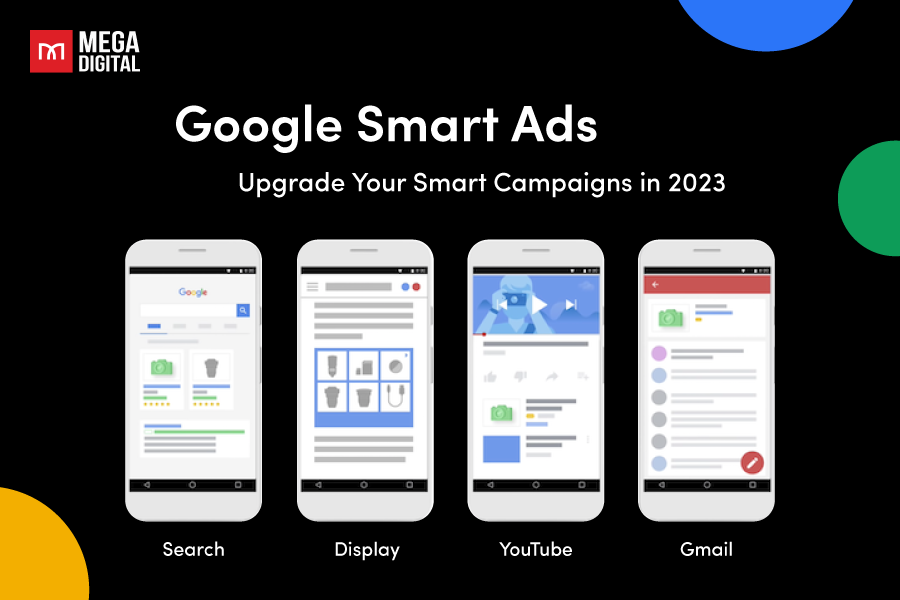
Smart Campaigns are a simplified, automated form of Google Ads designed to help small businesses get started with online advertising. These campaigns leverage Google’s machine learning to create and manage ads, making it easier for businesses without extensive advertising expertise to effectively reach their target audience.
How They Work:
Smart Campaigns automate much of the advertising process. Here’s a more detailed look at how they operate:
- Initial Setup:
- Business Information: Advertisers provide basic information about their business, including their advertising goals, budget, and a few creative elements such as business descriptions, images, and videos.
- Keyword Selection: Google uses machine learning to automatically select relevant keywords based on your business type and goals. These keywords trigger your ads to appear when users search for related terms.
- Ad Creation:
- Automated Ad Generation: Google’s AI generates text and image ads based on the information you provide. It creates multiple ad variations to determine which perform best.
- Placement Optimization: Ads are placed across Google’s networks, including Search, Display, Maps, and YouTube, that is, to reach potential customers wherever they are.
- Real-Time Adjustments:
- Continuous Optimization: Google’s AI continuously monitors the performance of your ads, making real-time adjustments to bids, keywords, and ad placements to maximize results.
- Performance Tracking: To start, The system tracks conversions, clicks, and other key metrics, using this data to further refine ad targeting and optimization.
- Reporting and Insights:
- Automated Reports: Google provides easy-to-understand reports that summarize the performance of your ads, including insights on what’s driving results and areas for improvement.
- Goal-Based Performance: The AI focuses on achieving your specified goals, whether that’s more website visits, phone calls, or in-store visits, ensuring that the campaign aligns with your business objectives.
Who They’re Best For:
Smart Campaigns are ideal for:
- Small Businesses:
- Limited Resources: Small businesses often lack the time or resources to manage complex ad campaigns. Smart Campaigns simplify the process, allowing business owners to focus on their core operations.
- Budget Constraints: These campaigns are designed to work within smaller budgets, making them accessible to businesses that might not have large advertising funds.
- New Advertisers:
- Ease of Use: For those new to online advertising, Smart Campaigns provide an intuitive, easy-to-use platform that doesn’t require in-depth knowledge of PPC strategies or keyword research.
- Quick Setup: The straightforward setup process allows new advertisers to get started quickly without needing to understand the technical details of ad creation and management.
- Local Businesses:
- Local Targeting: Smart Campaigns are particularly effective for local businesses aiming to attract nearby customers. Ads can be targeted to specific geographic areas, helping to drive local traffic.
- Map Integration: Ads can appear on Google Maps, therefore, making it easier for potential customers to find and visit physical locations.
- Ecommerce Businesses:
- Online Sales: Businesses selling products online can benefit from automated ad creation and placement, reaching potential customers across various Google platforms.
- Dynamic Ads: Smart Campaigns can dynamically update product information, ensuring that ads always show the latest inventory and pricing.
- Time-Constrained Businesses:
- Automated Management: Businesses that do not have dedicated marketing staff can rely on the automation and AI-driven management of Smart Campaigns to handle most of the workload.
- Performance Maximization: The continuous optimization ensures that the ads are always performing at their best, reducing the need for constant manual adjustments.
Types of Smart Ads
- Search Ads: Text-based ads that appear on the Google search results page when users search for relevant keywords.
- Display Ads: Banner and image ads shown on websites within the Google Display Network.
- Maps Ads: Ads that appear on Google Maps, helping to drive local traffic to physical locations.
- YouTube Ads: Video ads that appear on YouTube, increasing brand visibility through engaging visual content.
5 Tips to Optimize Smart Campaigns:
1. Set Clear Objectives:
Define what you want to achieve with your Smart Campaigns, whether it’s driving website visits, generating phone calls, or increasing in-store visits. Therefore, Clear objectives guide the AI in optimizing your ads effectively.
2. Provide Quality Creative Assets:
Supply high-quality images, engaging text, and relevant business information. The more accurate and appealing your creative elements are, the better Google can generate effective ads. Ensure your images and descriptions accurately reflect your business and offerings.
3. Use Accurate Targeting Information:
Provide precise details about your target audience, including location, language, and demographic preferences. This helps Google’s AI to better tailor your ads to reach the right customers. in fact, Regularly update your business information to maintain relevancy.
4. Monitor Performance Regularly:
Even though Smart Campaigns are automated, it’s important to regularly review performance metrics such as clicks, impressions, and conversions. In addition, Monitoring these metrics allows you to understand what’s working and make necessary adjustments to improve campaign performance.
5. Optimize Budget Allocation:
Ensure you allocate an appropriate budget based on your advertising goals and the competitive landscape of your industry. Google’s AI can optimize bids within your budget, but it needs sufficient resources to collect data and learn what works best. Adjust your budget as needed based on performance insights.
7. Google Ads App Campaigns
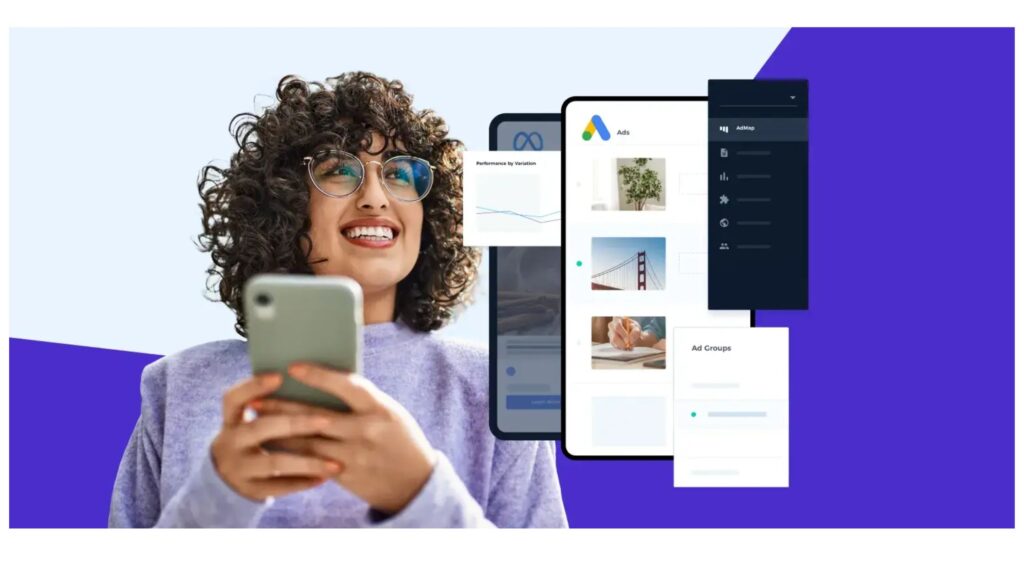
App campaigns are designed to promote mobile apps by driving downloads and increasing engagement. These campaigns can appear across multiple Google properties, including Search, Google Play, YouTube, Discover on Google Search, and the Google Display Network. Moreover, They use a few lines of text and images from your app store listing to create visually appealing ads.
How They Work
Google Ads App campaigns automate much of the advertising process using machine learning. Here’s how they function in detail:
- Campaign Setup:
- Input Information: Advertisers provide text, images, videos, and other relevant assets from their app store listing.
- Settings Configuration: Advertisers set campaign parameters such as budget, bid amount, and target locations.
- Ad Creation:
- Automated Ad Generation: Google uses the provided assets to automatically generate various ad formats. These can include text ads, image ads, and video ads, tailored to fit different placements and devices.
- Dynamic Adjustments: Google’s algorithms dynamically adjust the ad content and format to optimize performance based on user interactions and data.
- Placement and Targeting:
- Multiple Platforms: Ads can appear on Google Search, Google Play, YouTube, Discover on Google Search, and the Google Display Network, maximizing reach.
- Machine Learning Optimization: Google’s AI continuously learns and optimizes which ads perform best, when and where to display them, and how to bid for ad placements.
- Performance Tracking:
- Real-Time Monitoring: The platform provides real-time performance tracking and insights, helping advertisers understand how their campaigns are performing.
- Goal Optimization: Google optimizes ads to meet specific goals, such as increasing app installs, driving user engagement, or encouraging pre-registration for new apps.
Who They’re Best For
- App Developers and Publishers:
- App Launches: Ideal for developers looking to drive initial downloads and build a user base for new apps.
- User Engagement: Suitable for app publishers aiming to increase engagement and retention among existing users.
- Businesses with Mobile Apps:
- Ecommerce Apps: Great for businesses wanting to drive sales and interactions through their mobile shopping apps.
- Service Apps: Effective for companies offering services through apps, such as banking, fitness, or education, seeking to increase user engagement.
- Gaming Apps:
- Game Launches: Perfect for game developers to promote new games and drive installations.
- In-App Engagement: Helps in encouraging existing players to return and engage with the app more frequently.
Types of Google Ads App Campaigns:
- App Installs:
- Objective: Drive new users to download your app.
- Ad Features: Ads include a download button and direct users to the app store.
- App Engagement:
- Objective: Encourage existing app users to engage with specific features or content within the app.
- Ad Features: Ads drive users to a specific landing page or feature within the app.
- App Pre-Registration (Android Only):
- Objective: Build anticipation and a user base before the app is officially launched.
- Ad Features: Allows users to pre-register for the app on Google Play, Hence, ensuring they receive a notification when the app is available for download.
5 Tips to Optimize Google Ads App Campaigns:
1. Set Clear Goals:
Define precise objectives for your app campaign, whether it’s to increase app installs, drive in-app actions, or build a pre-launch user base. Moreover, Clear goals help Google’s AI to better optimize your ads for the desired outcomes.
2. Provide High-Quality Assets:
Supply a variety of high-resolution images, engaging videos, and compelling text. These assets should be visually appealing and accurately represent your app’s value proposition. Therefore, High-quality assets enhance ad performance across different placements.
3. Leverage Audience Targeting:
Utilize Google’s audience targeting features to reach users based on demographics, interests, and behaviors. Implement retargeting strategies to re-engage users who have previously interacted with your app, enhancing the likelihood of conversions.
4. Monitor and Adjust Budgets:
Regularly review your campaign performance metrics such as impressions, clicks, and installs. Adjust your budget and bids based on these insights to ensure optimal allocation of resources. Hence, Flexible bidding strategies can help maximize ROI.
5. Utilize Reporting and Insights:
Take advantage of Google’s detailed performance reports to track your campaign’s effectiveness. Analyze data to identify trends and patterns. Use these insights to refine your targeting, update your assets, and adjust your campaign strategies to improve overall performance. In addition, Regular A/B testing of different ad variations can also help identify the most effective elements.
8. Google Ads Discovery Campaigns
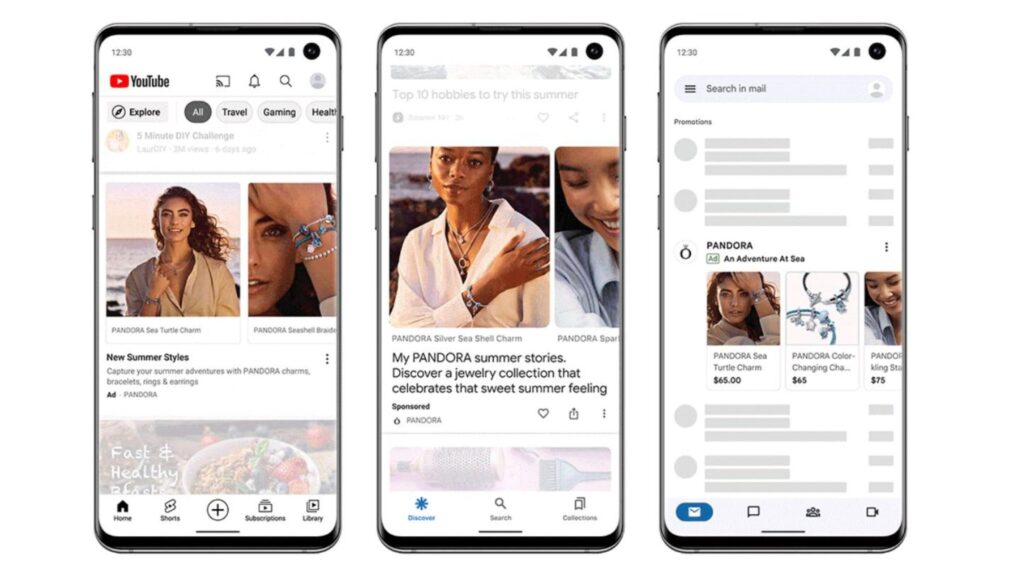
Discovery campaigns in Google Ads are designed to showcase your products or services across Google’s various feed placements, because enhancing user discovery. These ads appear in Gmail (Promotions and Social tab feeds), YouTube (Home feed and Watch Next feed), and the Google app (Discover feed). Therefore, The goal is to increase brand awareness through visually rich, engaging ads.
How They Work:
Google Ads Discovery campaigns leverage automation to manage the placement and optimization of ads. Here’s a detailed breakdown:
- Ad Creation:
- Asset Submission: Advertisers provide a variety of assets, including text, images, and videos.
- Automated Ad Generation: Google combines these assets to create dynamic ads tailored for different placements and audiences.
- Ad Placement:
- Automated Placement: Google automatically places ads across Gmail, YouTube, and the Google app, ensuring they appear in optimal locations to reach the target audience.
- Optimization:
- Machine Learning: Google’s AI continuously learns and optimizes which ad combinations and placements yield the best performance.
- Smart Bidding: Campaigns use Smart Bidding strategies to maximize results based on the advertiser’s goals, such as conversions or CPA targets.
- Performance Tracking:
- Insights and Reporting: Real-time data and performance reports are available, allowing advertisers to track the effectiveness of their campaigns and make informed adjustments.
Who They’re Best For:
- Businesses Seeking Brand Awareness:
- Wide Reach: Ideal for businesses aiming to increase brand visibility and reach new audiences through rich media ads.
- Ecommerce and Retail:
- Product Promotion: Effective for showcasing products to potential customers as they browse content on Google’s platforms.
- Advertisers Preferring Automation:
- Hands Off Management : Suitable for advertisers who prefer automated campaign management and optimization, focusing on strategic oversight rather than manual adjustments.
Types of Discovery Campaigns
- Text Ads:
- Description: Text-based ads that appear within Google’s feed environments, optimized for user engagement.
- Use Case: Ideal for conveying concise messages and driving clicks to your website.
- Image Ads:
- Description: Visually appealing ads featuring high-quality images to capture user attention.
- Use Case: Great for showcasing products or services in an engaging manner.
- Video Ads:
- Description: Video content that plays within feeds, capturing user interest through motion and sound.
- Use Case: Effective for storytelling and demonstrating products or services.
05 Tips to Optimize Discovery Campaigns
1. Set Clear Goals
To optimize your Google Ads Discovery campaigns, start by clearly defining your objectives. Whether your goal is to increase brand awareness, drive website traffic, or boost conversions, having specific, well-outlined objectives helps Google’s AI to optimize your campaigns more effectively. Implement robust conversion tracking to measure the success of your objectives, providing critical data for continuous optimization. By setting clear goals and tracking conversions, you ensure that your campaigns are focused and results-driven, making it easier to evaluate performance and make necessary adjustments.
2. Provide High-Quality Assets
The quality of your ad assets plays a crucial role in the success of your Discovery campaigns. Provide a diverse range of high-resolution images, engaging videos, and compelling text to ensure your ads are adaptable across various placements. Mobile optimization is particularly important, as a significant portion of traffic comes from mobile devices. Ensure that all your assets are optimized for mobile viewing to enhance user engagement and click-through rates. Regularly refreshing your creative assets can also help prevent ad fatigue and keep your audience engaged with fresh, relevant content.
3. Leverage Audience Targeting
Effective audience targeting is key to maximizing the impact of your Discovery campaigns. Use Google’s audience targeting features to reach specific demographics, interests, and behaviors, ensuring that your ads are seen by the most relevant users. Implement retargeting strategies to re-engage users who have previously interacted with your brand, increasing the likelihood of conversions. By leveraging detailed targeting and retargeting, you can enhance ad relevancy and engagement, driving better results from your campaigns.
4. Monitor and Adjust Budgets
Regularly reviewing your campaign performance metrics, such as impressions, clicks, and conversions, is essential for optimizing your budget allocation. Based on performance insights, adjust your daily and overall campaign budgets to allocate more resources to high-performing ads and reduce spend on underperforming ones. Utilizing Smart Bidding strategies like Target CPA or Maximize Conversions can help optimize your budget usage by adjusting bids in real-time based on auction outcomes. This flexible approach ensures that your ad spend is maximized for efficiency and effectiveness.
5. Utilize Reporting and Insights
Accessing and analyzing Google’s detailed performance reports is vital for understanding how your ads are performing across different channels. Use these insights to identify trends and patterns that can inform your campaign strategies. Continuously test different ad variations through A/B testing to determine what works best. Experiment with various headlines, images, videos, and CTAs to optimize for better performance. By leveraging reporting and insights, you can make data-driven decisions that refine your targeting, assets, and bidding strategies, enhancing the overall effectiveness of your Discovery campaigns.
Dont’s of running a Google Ads Campaign
1. Don’t Use Broad Match Keywords Exclusively
- Issue: If you run a bakery and use the broad match keyword “cake,” your ad might appear for searches like “cake recipes” or “how to bake a cake,” which aren’t relevant to your business.
- Solution: Use more specific match types.
- Example:
- Phrase Match: “buy cake”
- Exact Match: [chocolate cake shop]
- Broad Match Modified: +buy +cake +bakery
- Regularly check your search term reports to add negative keywords like “recipe” or “baking class.”
- Example:
2. Don’t Ignore Negative Keywords
- Issue: If you’re an online clothing retailer specializing in premium brands, your ads might show for searches like “cheap clothes” or “free clothing samples.”
- Solution: Add negative keywords to filter out irrelevant traffic.
- Example: Add negative keywords like “cheap,” “free,” “discount,” and “second-hand.”
- Review search term reports to continuously refine your negative keyword list.
3. Don’t Overlook Ad Extensions
- Issue: A simple ad for a plumbing service that only shows a headline and description might not stand out.
- Solution: Use ad extensions to provide more information and options.
- Example:
- Sitelink Extension: “Emergency Services,” “Water Heater Installation,” “Drain Cleaning.”
- Callout Extension: “24/7 Service,” “Licensed and Insured,” “Free Estimates.”
- Location Extension: Show your business address and distance from the searcher.
- Call Extension: Include a direct phone number for quick calls.
- Ad extensions make your ad more informative and clickable, potentially increasing CTR.
- Example:
4. Don’t Set and Forget Campaigns
- Issue: If you set up a seasonal ad for holiday sales and don’t monitor it, you might miss out on performance tweaks and overspend after the season ends.
- Solution: Regularly review and optimize campaigns.
- Example:
- Weekly Check-ins: Adjust bids based on performance, pause underperforming keywords, update ad copy.
- Monthly Reviews: Analyze performance data, A/B test different ad copies, review conversion tracking.
- Automated Rules: Set rules to increase bids on high-performing keywords or pause low-performing ads automatically.
- Example:
5. Don’t Neglect Mobile Optimization
- Issue: A clothing store with a non-responsive website may see high bounce rates from mobile users.
- Solution: Ensure ads and landing pages are mobile-friendly.
- Example:
- Responsive Design: Make sure your website adjusts to various screen sizes.
- Mobile-Specific Ads: Create ads specifically tailored for mobile users.
- Mobile Bid Adjustments: Increase bids for mobile devices if you see better conversion rates from mobile traffic.
- Fast Loading Speed: Ensure your website loads quickly on mobile to reduce bounce rates.
- Example:
6. Don’t Use Misleading Ad Copy
- Issue: An ad for a free trial software that leads to a landing page requiring payment details upfront can disappoint users.
- Solution: Write clear and honest ad copy.
- Example:
- Accurate Ad Copy: “Free 30-Day Trial” here instead of “Free Software.”
- Consistent Experience: Ensure the landing page highlights the free trial without unexpected costs or requirements.
- This builds trust and reduces bounce rates, leading to better performance metrics.
- Example:
7. Don’t Ignore Quality Score
- Issue: A poorly optimized ad with a low Quality Score results in higher CPCs and lower ad positions.
- Solution: Focus on improving Quality Score components.
- Example:
- Ad Relevance: Make sure your ad copy is directly related to the keywords and the landing page. For a bakery, use keywords like “best chocolate cake” and ensure the ad mentions “freshly baked chocolate cakes” with a landing page about your chocolate cake offerings.
- Expected CTR: Use compelling and action-oriented language in your ads. Instead of “Visit our bakery,” use “Order Fresh Cakes Online Now.”
- Landing Page Experience: Ensure the landing page is relevant to the ad, loads quickly, and is easy to navigate. If your ad is about chocolate cakes. in fact, the landing page should showcase your chocolate cakes with easy ordering options.
- Example:
To conclude,
Google Ads offers a diverse array of ad formats designed to meet various marketing objectives and target audiences effectively. Search ads appear on Google’s search results, ideal for capturing intent-driven traffic. Shopping ads showcase product details directly within search results, driving high-intent traffic to e-commerce sites. App ads promote app installs and engagement across Google’s vast network. Local ads attract nearby customers to physical locations. To conclude, Smart ads use automated, AI-driven strategies for optimized performance, and in addition, Discovery ads appear across Google’s feeds, such as YouTube, Gmail, and Discover, therefore, ensuring broad reach and engagement. finally, Together, these ad formats provide a comprehensive toolkit for advertisers to reach their target audience at every stage of the customer journey, from awareness to conversion.
Subscribe to our youtube now – https://www.youtube.com/@theinspyr

